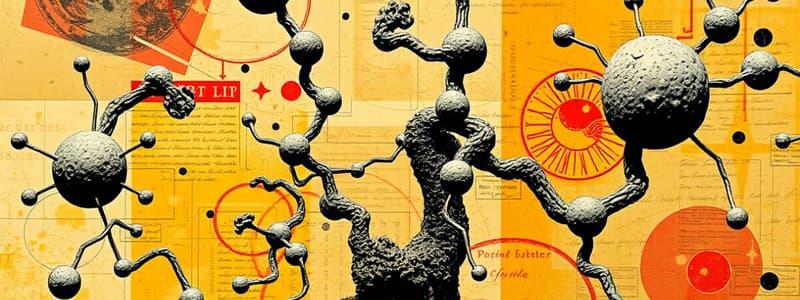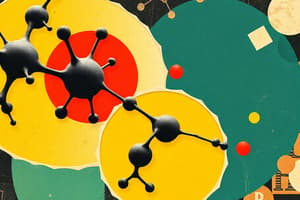Podcast
Questions and Answers
What are proteins primarily constructed from?
What are proteins primarily constructed from?
- Amino acids (correct)
- Nucleotides
- Simple sugars
- Fatty acids
Which of the following structures represents the overall three-dimensional shape of a protein?
Which of the following structures represents the overall three-dimensional shape of a protein?
- Quaternary structure
- Tertiary structure (correct)
- Secondary structure
- Primary structure
What is a key function of fats in the body?
What is a key function of fats in the body?
- Creating antibodies
- Storing energy (correct)
- Conducting electricity in neurons
- Transmitting genetic material
Which type of lipid is responsible for forming the cell membrane?
Which type of lipid is responsible for forming the cell membrane?
What are nucleic acids primarily made of?
What are nucleic acids primarily made of?
What components make up the backbone of a DNA molecule?
What components make up the backbone of a DNA molecule?
What is the primary function of nucleic acids?
What is the primary function of nucleic acids?
What hypothesis proposes that life originated from gasses in the early Earth's atmosphere?
What hypothesis proposes that life originated from gasses in the early Earth's atmosphere?
Which type of tissue is responsible for covering and protecting organs?
Which type of tissue is responsible for covering and protecting organs?
Which organelle is primarily involved in the release of energy from food in animal cells?
Which organelle is primarily involved in the release of energy from food in animal cells?
Which statement about ribosomes is correct?
Which statement about ribosomes is correct?
What characterizes the fluid mosaic model of the cell membrane?
What characterizes the fluid mosaic model of the cell membrane?
What is the primary function of microtubules in the cytoskeleton?
What is the primary function of microtubules in the cytoskeleton?
Which type of cell contains both a nucleus and membrane-bound organelles?
Which type of cell contains both a nucleus and membrane-bound organelles?
What effect does a hypotonic environment have on plant cells?
What effect does a hypotonic environment have on plant cells?
Which of the following accurately describes the lytic cycle of bacteriophages?
Which of the following accurately describes the lytic cycle of bacteriophages?
Which structure in chloroplasts is responsible for converting light energy into chemical energy?
Which structure in chloroplasts is responsible for converting light energy into chemical energy?
What is one main function of the cytoskeleton in a cell?
What is one main function of the cytoskeleton in a cell?
Which organelle is responsible for energy production through cellular respiration?
Which organelle is responsible for energy production through cellular respiration?
How does the nucleus contribute to gene expression?
How does the nucleus contribute to gene expression?
Which component of the cell membrane allows for fluid movement?
Which component of the cell membrane allows for fluid movement?
What role do lysosomes play in a cell?
What role do lysosomes play in a cell?
What structure of the mitochondria is responsible for increasing surface area for chemical reactions?
What structure of the mitochondria is responsible for increasing surface area for chemical reactions?
Which process takes place inside the mitochondria to convert food into usable energy?
Which process takes place inside the mitochondria to convert food into usable energy?
Which of the following describes the structure of the nucleus?
Which of the following describes the structure of the nucleus?
What type of proteins make up microfilaments in the cytoskeleton?
What type of proteins make up microfilaments in the cytoskeleton?
What mechanism do living organisms primarily use to regulate homeostasis?
What mechanism do living organisms primarily use to regulate homeostasis?
Study Notes
Protein Molecules
- Proteins are organic molecules composed of carbon, hydrogen, nitrogen, oxygen, and sulfur.
- Proteins are formed from amino acids linked into polypeptide chains during translation.
- Primary structure refers to the specific sequence of amino acids.
- Secondary structure involves hydrogen bonding, creating beta sheets or alpha helices.
- Tertiary structure represents the overall three-dimensional shape of the protein.
- Quaternary structure arises from the assembly of multiple polypeptide chains.
- Extreme pH or high temperature can cause proteins to denature, losing their functional conformation.
Lipids
- Lipids are biological molecules that are insoluble in water, primarily composed of fatty acids.
- Types of lipids include triglycerides (fats), waxes, steroids, and phospholipids.
- Triglycerides consist of three fatty acids linked to glycerol, well-known for energy storage.
- Fat-soluble vitamins, essential for the body, include A, D, E, and K.
- Steroids are formed from four fused hydrocarbon rings and are crucial for hormone production.
- Waxes protect plant leaves and provide structural functions for organisms, such as bees.
- Phospholipids make up cell membranes, enabling passive transport of necessary substances.
Nucleic Acids
- Nucleic acids, long-chain polymers of nucleotides, are key components of living organisms.
- Major types include DNA and RNA, with DNA consisting of purines (adenine, guanine) and pyrimidines (cytosine, thymine).
- DNA forms a double helix structure, resembling a twisted ladder.
- Nucleotides form base pairs via hydrogen bonds: Guanine-Cytosine (three bonds) and Adenine-Thymine (two bonds).
- Primary functions include storage of genetic information and guiding cell reproduction.
Abiotic Synthesis
- Abiotic synthesis creates organic molecules from non-living components.
- The Oparin-Haldane hypothesis suggests life originated from gases in the early Earth's atmosphere.
- The Miller-Urey experiment demonstrated potential pathways for organic molecule formation without cellular life.
Characteristics of Organisms
- An organism can respond to stimuli, reproduce, grow, adapt, and maintain homeostasis.
- Homeostasis involves internal balancing processes crucial for organism function.
- Three domains of life are Bacteria, Archaea (prokaryotes), and Eukarya (eukaryotes).
- Cellular organization ranges from unicellular prokaryotes to multicellular eukaryotes, with cells as the smallest unit of life.
Animal Cells
- Animal cells, eukaryotic in nature, possess a nucleus, mitochondria, and various organelles.
- The structure includes a cell membrane, cytoplasm, and organelles like ribosomes and Golgi bodies.
- Mitochondria act as powerhouses by converting food into energy through cellular respiration.
- Ribosomes synthesize proteins, found freely in the cytoplasm or attached to the endoplasmic reticulum.
Cell Membrane
- The cell membrane is a flexible barrier, primarily composed of phospholipids arranged in a bilayer.
- The membrane contains cholesterol for fluidity and proteins for transport, signaling, and adhesion.
- Carbohydrates form the glycocalyx, enhancing cell adhesion and recognition.
- The fluid mosaic model describes the membrane's dynamic structure.
Homeostasis
- Homeostasis maintains optimal internal conditions in organisms through negative feedback mechanisms.
- Mechanisms include temperature regulation, water and salt balance, and glucose levels.
- The cell membrane plays a vital role in regulating substance movement and ion concentration.
Organelles and Their Functions
- The nucleus controls cellular activities, contains genetic material, and regulates gene expression.
- The endoplasmic reticulum (ER) transports materials inside the cell; rough ER has ribosomes and synthesizes proteins.
- Mitochondria conduct cellular respiration, producing ATP for energy.
- Lysosomes digest food and waste, while Golgi bodies package proteins for transport.
Mitochondria
- Mitochondria are double-membrane organelles involved in cellular respiration and ATP production.
- The inner membrane is folded into cristae, enhancing the surface area for energy production.
- Prokaryotic cells rely solely on their environment for energy as they lack mitochondria.
Cytoskeleton
- The cytoskeleton provides structural support and facilitates intracellular transport and chromosome separation during cell division.
- Composed of protein fibers (microfilaments, intermediate filaments, microtubules) that vary in size and function.
Prokaryotes vs. Eukaryotes
- Prokaryotic cells lack a nucleus and membrane-bound organelles, are typically unicellular, and have circular DNA.
- Eukaryotic cells contain a nucleus and organelles, can be unicellular or multicellular, and possess linear DNA.
Plant Cells
- Plant cells have central vacuoles for water storage, waste elimination, and maintaining turgor pressure.
- Cell walls, made of cellulose, provide structural rigidity and flexibility.
- Turgor pressure is crucial for plant cell stability and occurs in hypotonic environments.
Chloroplasts
- Chloroplasts are organelles in plant and algae cells involved in photosynthesis.
- They contain two membranes and structures like thylakoids where light energy is converted into chemical energy.
Viral Replication Cycles
- Bacteriophages undergo lytic and lysogenic cycles for replication.
- Lytic cycle results in host cell lysis and rapid virus reproduction; lysogenic cycle integrates virus DNA into the host genome without immediate cell damage.### Phage and Lysogeny
- Phage genome that integrates into the host genome is termed a prophage.
- Bacteria harboring a prophage are known as lysogens.
- Phage genome replication occurs in tandem with host DNA replication, but it does not completely dominate host cellular machinery.
Lysogenic Cycle
- The productivity of phage genome is low during the lysogenic cycle.
- This cycle is characterized by a lack of progeny virus particles, making it a time-consuming process.
- Environmental factors like UV light, nutrient deprivation, or specific chemicals can trigger the transition from the lysogenic cycle to the lytic cycle.
Lytic Cycle Steps
- Adsorption: Phage attaches to the bacterial surface.
- Penetration: Bacterial cell entry occurs, allowing the phage to inject its genome.
- Replication and Biosynthesis: Phage genome replicates, and components for new virions are synthesized.
- Maturation: Newly formed virions assemble into complete virus particles.
- Lysis and Release: The host cell lyses, releasing new virus particles into the environment.
Additional Concepts
- An empty phage particle remaining outside the host is referred to as a ghost.
- The lysogenic cycle consists of adsorption, penetration, integration of phage genome into the bacterial chromosome as a prophage, followed by phage genome replication along with the host genome.
- Prophage presence can induce changes in the host’s phenotypes, a phenomenon known as lysogenic conversion.
Studying That Suits You
Use AI to generate personalized quizzes and flashcards to suit your learning preferences.
Description
Test your knowledge of biological macromolecules in this quiz focused on proteins, fats, and nucleic acids. Answer questions about the structure and functions of these essential biomolecules and understand their roles in the body. Perfect for biology students looking to reinforce their understanding of this crucial topic.



